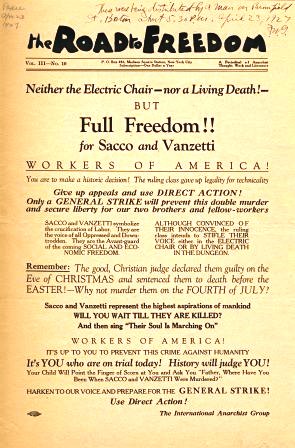By Susan Martin, Collections Services
Today marks the 90th anniversary of the execution of Nicola Sacco and Bartolomeo Vanzetti at Charlestown State Prison. Sacco and Vanzetti were Italian immigrants and anarchists convicted for killing two men in South Braintree, Mass. on 15 April 1920. Their notorious trial, described and debated by many qualified historians in the intervening decades, is still hotly contested to this day. I’d like to concentrate on the immediate aftermath of the case, as told to us by an eyewitness.

Robert E. Grant was captain of the Hyde Park (Boston) Police Department at the time of the trial and execution of Sacco and Vanzetti. The MHS holds in its collections the diaries Grant kept off and on between 1901 and 1930, which my colleague Brendan Kieran wrote about in an earlier Beehive post. Grant played a role in the Sacco-Vanzetti story primarily because the prosecutor of the case, District Attorney Frederick G. Katzmann, lived in his district.

The trial and verdict sparked protests and bombings around the world, and individuals associated with the prosecution were threatened, including Katzmann. As early as June 1926, shortly after the Massachusetts Supreme Judicial Court upheld the conviction of Sacco and Vanzetti, Captain Grant dispatched a police detail to Katzmann’s home in Hyde Park.
Sent two men first and last half to watch the Katzmann house #11 Prospect Street for bombs. Sacco and Vanzetti Sympithy. [1 June 1926]
On 9 April 1927, Sacco and Vanzetti were sentenced to death by Judge Webster Thayer of the Superior Court in Dedham, Mass. Supporters were outraged, as you can see in this broadside distributed by the International Anarchist Group.

Facing intense pressure and petitions for clemency, Massachusetts Governor Alvan T. Fuller appointed a three-man advisory committee to review the case and determine if it had been prosecuted fairly. On 3 August 1927, the committee sustained the decision of the court, and protests intensified. Throughout the spring and summer of 1927, Captain Grant and the Hyde Park police kept a watchful eye on Katzmann’s home and other hot spots. It appears they even tapped the district attorney’s phone line.
Had 3 men sent here [from other districts] for Katzman Detail this am. […] Sent to Capt Lutz [of the Riot Squad] for three Riot Guns to send to Katzman house. [I] went out to telephone Co. about quick service to Katzmans house. They told me they would do so. [4 August 1927]
Order came out noon mail that all Days Off are suspended and Night and Day men to sleep in and report back for duty on long days on Account of boms in other Cities. [6 August 1927]
Very quiet here. Capt. Lutz was out and went to the house of Katzmans to instruct the men about shot guns. They have to be told every day. [17 August 1927]
One of the jurors in the case, Lewis McHardy of East Milton, Mass., was also targeted.
Learned of the Boming of the house of McHardy one of the Sacco Jurors. Five asleep about 4 this am. None injured. House badly damaged. […] Went to Katzmans Office to talk this matter of bomming over with him. […] No arrests here or Milton on the Bomming case. [16 August 1927]
Sacco and Vanzetti lost their appeals and were executed on 23 August 1927, along with Celestino Madeiros (for another murder).
Supreme Court handed down a disision against Sacco Vanzetti for new trial and stay of sentence. Orders again came out holding all men over time at station beginning tomorrow morning. Look out for boms. [19 August 1927]
Every thing is ready for Sacco Vanzetti in the Electric Chair to night after 12 midnight. […] Saw the details at Tel building, Public Library and later at Katzman house. […] They are all ready for the Execution of Sacco and Vanzetti and Maderos at State prison. [22 August 1927]
At Station untill 12-40 am. Day men Excused. Sacco Venzetti Maderos Elicetruded at 12.27 am. […] Things very quiet here after the Execution of Sacco-Venzetti. [23 August 1927]
The MHS holds the six-volume transcripts of the case, published in 1928-1929 and given to us by Felix Frankfurter. I found, folded up in the front of volume one, the September 1927 bulletin of the Sacco-Vanzetti Defense Committee. It describes injustices perpetrated against the accused men by Katzmann, Thayer, Fuller, and others, and includes an article entitled “The Hatred in High Places That Murdered Sacco and Vanzetti.”

In 1977, Massachusetts Governor Michael Dukakis issued a proclamation declaring that Sacco and Vanzetti had not received a fair trial. The proclamation argued that “the atmosphere of their trial and appeals was permeated by prejudice against foreigners and hostility toward unorthodox political views,” and Dukakis encouraged the people of Massachusetts
to reflect upon these tragic events, and draw from their historic lessons the resolve to prevent the forces of intolerance, fear, and hatred from ever again uniting to overcome the rationality, wisdom, and fairness to which our legal system aspires.

